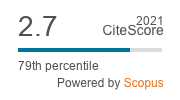Demonstration for Fermat’s last theorem and Beal’s conjecture
Keywords:
Pythagorean Theorem, Fermat’s Last Theorem, Beal Conjecture Classification AMS: 11D41Abstract
Fermat’s Last Theorem (FLT), 1637, states that if n is an integer greater than 2, then it is impossible to find three positive integer numbers x, y and z in xn yn zn where such equality is met being (x,y) coprime. Beal’s Conjecture (BC), 1993, states that in equation Ax + By Cz , where (A,B,C,x, y,z) and (x, y,z)>2 are different exponents, then (A,B,C) must have a prime factor, for positive integer solutions, but if are coprime and the exponents (x, y,z)>2 are different, there are no positive integer solutions. The present proof contains two theorems that finally allow us to demonstrate the Beal Conjecture, transforming the equation of Beal conjecture into the form of Fermat’s Last Theorem equation. Since there are no solutions in positive integer numbers for Fermat’s Last Theorem equation, then the Beal’s Conjecture does not have solution in positive integer numbers for unequal exponents or with two equal exponents, but all greater than two, being two of their bases coprime.
References
Cox, D. A., Introduction to Fermat’s last theorem, Amer. Math. Monthly, 101 (1), (1994), 3–14.
Singh, S., Fermat’s Last Theorem, London. 1997. ISBN 1-85702-521-0.
Ribenboim, P., The history of Fermat’s last theorem (Portuguese), Bol. Soc. Paran. Mat., (2) 5 (1), (1984), 14–32.
Heath-Brown, D. R., The first case of Fermat’s last theorem, Math. Intelligencer, 7 (4), (1985), 40–47.
Cox, D. A., Introduction to Fermat’s last theorem, Amer. Math. Monthly, 101 (1), (1994), 44–45.
Barlow, P., An Elementary Investigation of Theory of Numbers, St. Paul’s Church-Yard, London: J. Johnson, (1811), 144–145.
Gautschi, W., Leonhard Euler: His Life, the Man, and His Work. SIAM Review 50 (1), (2008), 3–33.
Mačys, J.—J., On Euler’s hypothetical proof, Mathematical Notes, 82 (3–4), (2007), 352–356.
Del Centina, A., Unpublished manuscripts of Sophie Germaine and a revaluation of her work on Fermat’s Last Theorem. Archive for History of Exact Sciences, 62 (4), (2008), 349–392. Web. September 2009.
Carmichael, R.—D., The Theory of numbers and Diophantine Analysis. Dover N. Y. (1959).
Legendre, A.M., Research on some analysis of unknown objects, particularly on Fermat’s theorem (in French) Mem. Acad. Roy. Sci. Institut France, 6, (1823), 1–60.
Van der Poorten, A., Remarks on Fermat’s last theorem, Austral. Math. Soc. Gaz., 21 (5), (1994), 150–159.
Lamé, G., Memory on Fermat’s Last Theorem (in French), C. R. Acad. Sci. Paris, 9, (1839), 45–46.
Lamé, G., Memory of the undetermined analysis demonstrating that the equation x7 y7 z7 is impossible in integer numbers (in French), J. Math. Pures Appl., 5, (1840), 195–211.
De Castro Korgi, R., The proof of Fermat’s last theorem has been announced in Cambridge, England (Spanish), Lect. Mat., 14, (1993), 1–3.
Wiles, A., Modular elliptic curves and Fermat’s Last Theorem (PDF). Annals of Mathematics, 141 (3), (1995), 443–531. https://doi.org/10.2307/211855
Van der Poorten, A., Remarks on Fermat’s last theorem, Austral. Math. Soc. Gaz., 21 (5), (1994), 150–159.
De Castro Korgi, R., The proof of Fermat’s last theorem has been announced in Cambridge, England (Spanish), Lect. Mat., 14, (1993), 1–3.
Wiles, A., Modular elliptic curves and Fermat’s Last Theorem (PDF). Annals of Mathematics, 141 (3), (1995), 443–531. https://doi.org/10.2307/211855
Ribet, K., Galois representation and modular forms. Bulletin AMS 32, (1995), 375–402.
Ribet, K. A. From the Taniyama-Shimura Conjecture to Fermat’s Last Theorem, Ann. Fac. Sci. Toulouse Math., 11, (1990), 116–139.
Serge, L., Some History of the Shimura-Taniyama Conjecture. Notices of the AMS. 42 (11), (1995), 301–1307.
Gerhard, F., Links between stable elliptic curve and certain Diophantine equations. Annals Universitatis Saraviensis, Series Mathematicae 1 (1), iv–40. 1986. ISSN 0933-8268, MR 853387.
Gerd, F., The proof of Fermat’s Last Theorem R. Thaylor and A. Wiles. Notices of the AMS, 42 (7), (1995), 743–746.
Darmon, H., Deamond, F., and Taylor, R., Fermat’s Last Theorem. Current Developments in Math. International Press. Cambridge MA, (1995), 1–107.
Kleiner, I., From Fermat to wiles: Fermat’s Last Theorem Becomes a Theorem. Elem. Math., 55, (2000), 19–37. https://doi.org/10.1007/PL00000079
Golfeld, D., Beyond the Last Theorem, Math. Horizons, 34, (1996), 26–31.
Porras Ferreira, J., William “Solution for Fermat’s Last Theorem”, Revista Científica General José María Córdova, 14 (17), (2016), 412–419.
Breen, M., and Emerson, A., Beal Conjecture Prize Increased to $1 Million, America Mathematical Society. Bull. (2013).
Abramson, A., Billionaire offers $1 million to solve, Math. Problem. abcNews. (2013).
Waldschmidt, M., On the abc Conjecture and some its consequences. 6th World conference on 21th Century Mathematics. Abdus Salan School of Mathematical Sciences (ASSMS) Lahore (Pakistan). (2013), 1–79.
Mauldin, R. D., A Generalization of Fermat’s Last Theorem: The Beal’s Conjecture and Prize Problem. Notices of the AMS, 44 (11), (1997), 1436–1439.
Harold, M., Edward’s., A Genetic Introduction to Algebraic Number Theory. Graduate Texts in Mathematics 50. New York Springer. 2000. ISBN 0-387-95002-8.
Darmon, H., and Granville, A., On the equations zm F(x,y) and Ax p Byq Czr . Bull, London, Math. Soc. 27, (1995), 513–543.




